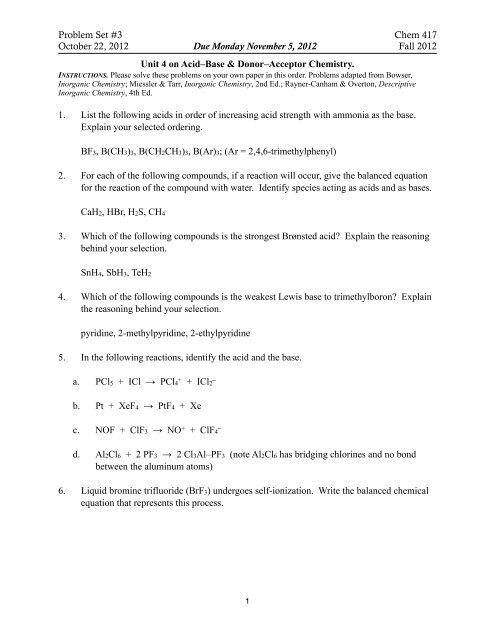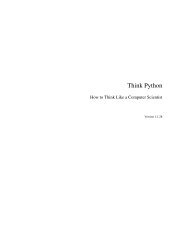problem set 3 417 2012 - Personal Pages - Denison University
problem set 3 417 2012 - Personal Pages - Denison University
problem set 3 417 2012 - Personal Pages - Denison University
- No tags were found...
You also want an ePaper? Increase the reach of your titles
YUMPU automatically turns print PDFs into web optimized ePapers that Google loves.
Problem Set #3 Chem <strong>417</strong><br />
October 22, <strong>2012</strong> Due Monday November 5, <strong>2012</strong> Fall <strong>2012</strong><br />
Unit 4 on Acid–Base & Donor–Acceptor Chemistry.<br />
INSTRUCTIONS. Please solve these <strong>problem</strong>s on your own paper in this order. Problems adapted from Bowser,<br />
Inorganic Chemistry; Miessler & Tarr, Inorganic Chemistry, 2nd Ed.; Rayner-Canham & Overton, Descriptive<br />
Inorganic Chemistry, 4th Ed.<br />
1. List the following acids in order of increasing acid strength with ammonia as the base.<br />
Explain your selected ordering.<br />
BF3, B(CH3)3, B(CH2CH3)3, B(Ar)3; (Ar = 2,4,6-trimethylphenyl)<br />
2. For each of the following compounds, if a reaction will occur, give the balanced equation<br />
for the reaction of the compound with water. Identify species acting as acids and as bases.<br />
CaH2, HBr, H2S, CH4<br />
3. Which of the following compounds is the strongest Brønsted acid Explain the reasoning<br />
behind your selection.<br />
SnH4, SbH3, TeH2<br />
4. Which of the following compounds is the weakest Lewis base to trimethylboron Explain<br />
the reasoning behind your selection.<br />
pyridine, 2-methylpyridine, 2-ethylpyridine<br />
5. In the following reactions, identify the acid and the base.<br />
a. PCl5 + ICl → PCl4 + + ICl2 –<br />
b. Pt + XeF4 → PtF4 + Xe<br />
c. NOF + ClF3 → NO + + ClF4 –<br />
d. Al2Cl6 + 2 PF3 → 2 Cl3Al–PF3 (note Al2Cl6 has bridging chlorines and no bond<br />
between the aluminum atoms)<br />
6. Liquid bromine trifluoride (BrF3) undergoes self-ionization. Write the balanced chemical<br />
equation that represents this process.<br />
1
7. In the following solution equilibria, use the concepts of hard-soft acid-base chemistry to<br />
predict if the products or reactants will be favored in each of the following reactions.<br />
Explain your answers.<br />
a. AgF(aq) + LiI(aq) AgI(aq) + LiF(aq)<br />
b. 2 Fe(OCN)3(aq) + 3 Fe(SCN)2(aq) 2 Fe(SCN)3(aq) + 3 Fe(OCN)2(aq)<br />
c. 2 CuCN(aq) + CuI2(aq) 2 CuI(aq) + Cu(CN)2(aq)<br />
8. Each of the following reactions lies toward the product side. On this basis only (without<br />
reference to pKa data tables) arrange all of the compounds that act as Brønsted acids in<br />
these reactions (there are five) in order of decreasing strength.<br />
H3PO4(aq) + N3 – (aq) HN3(aq) + H2PO4 – (aq)<br />
HN3(aq) + OH – (aq) H2O(l) + N3 – (aq)<br />
H3O + (aq) + H2PO4 – (aq) H3PO4(aq) + H2O(l)<br />
H2O(l) + PH2 – (aq) PH3(aq) + OH – (aq)<br />
9. Use the Drago parameters to calculate the approximate enthalpy change for:<br />
a. SO2 + C5H5N → C5H5N·SO2<br />
b. Me3N·BF3 + PMe3 → Me3P·BF3 + NMe3<br />
c. Me3Al·NMe3 + F3B·SEt2 → Me3Al·SEt2 + F3B·NMe3<br />
(See Table 6.8. For PMe3, CB = 6.55; EB = 0.838)<br />
2

















